Pump Handbook by Igor J. Karassik, Joseph P. Messina, Paul Cooper, Charles C. Heald - 3rd edition
Подождите немного. Документ загружается.

9.4 FIRE PUMPS 9.63
2. Determine the appropriate governing regulations: NFPA (North America), APSAD
(France), VDS (Germany), and so on.
3. Ensure the availability of sufficient water capacity, according to the type of risk. Pref-
erence should be given to a water supply above ground, which is generally more reli-
able and less expensive than a below-ground supply.
4. Distinguish all the critical areas and functions to be protected on the site.
5. Determine the motive power of the pump drivers. The objective is to be independent
from the site of risk. Diesel engine-driven installations many times provide a conve-
nient, independent power source that addresses this concern. The costs associated
with a diesel engine power source is usually equivalent to those of electrical installa-
tions; in some cases, they are even lower.
6. Provide a pump house, or a pump room, so the pump, driver and controller may be pro-
tected against possible damage or injury. In addition to the normal precautions and
concerns of a pump installation, also consider the following factors:
• Easy access for installation and maintenance
• Sufficient ventilation for motors and engines
• Risk of earthquakes
• Risk of freezing
• Noise protection, where required
7. Determine the pipe network and all required fittings and accessories in order to
obtain the lowest project costs.
8. Smaller pipe sizes (less expensive) increase friction losses and may require more pow-
erful (more expensive) pump sets.
9. Larger pipe sizes (more expensive) decrease friction losses and may allow the use of
less powerful (less expensive) pump sets.
Keep in mind the following factors when selecting a pump:
1. Compute the total capacity and pressure required to feed the protection system.
2. Determine the NPSH available at the pump suction nozzle. This is an important selec-
tion criterion for establishing the speed and design of the pump. Reminder: U.S regu-
lations forbid static suction lifts for fire pumps, whereas most European regulations
will allow limited suction lifts.
3. Select the highest possible pump speed based on the required capacity and the avail-
able NPSH.The higher the allowable pump speed, the lower the cost of the pump set.
Figures 8 and 9 give recommended operating speeds for single suction and double
suction pumps.
4. Select pump size and design according to the governing (applicable) regulations.
Drivers and Controllers As outlined earlier under “Fire Pump Criteria,” it is recom-
mended that a completely packaged fire pump set, including the pump(s), driver(s), con-
troller(s), headers, accessories and piping, mounted on a common base, be furnished.
PUMP DESIGN AND MATERIALS _______________________________________
Constant operational readiness and a high degree of operational reliability are the most
important aspects of fire pump designs. Although not mandatory, the features listed and
described next are recommended for fire pumps.
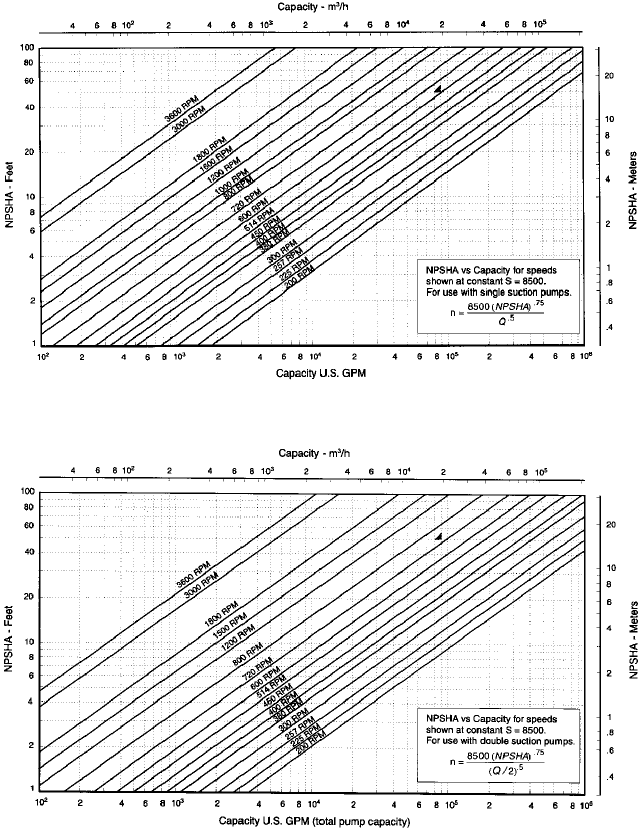
9.64 CHAPTER NINE
• Shaft sealing should be by means of stuffing boxes (packing).
• Grease-lubricated rolling element bearings should be used on horizontal pumps. Water-
lubricated (rubber) sleeve bearings (open line shaft) or oil-lubricated bronze sleeve bear-
ings (enclosed line shaft) and, if so equipped, a grease-lubricated thrust bearing should
be used on vertical pumps.
• Combinations of materials, running clearances, and rotor end plays should permit trou-
ble-free operation, even if the pump has been idle (not run) for extended periods of time.
FIGURE 8 Recommended operating speeds for single suction fire pumps (Hydraulic Institute ANSI/HI 2000
Edition Pump Standards, Refernce 1)
FIGURE 9 Recommended operating speeds for double suction fire pumps (Hydraulic Institute ANSI/HI 2000
Edition Pump Standards, Refernce 1)
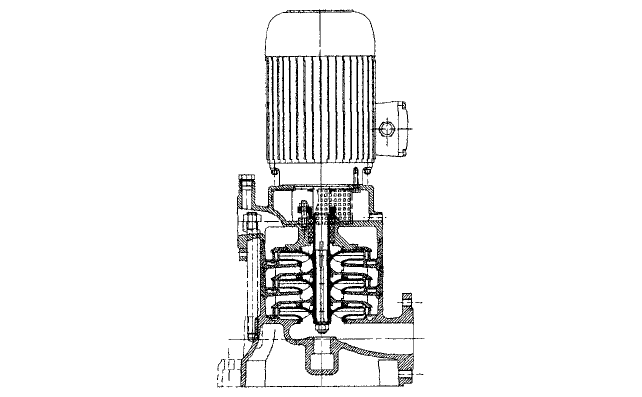
9.4 FIRE PUMPS 9.65
FIGURE 10 Small, vertical multistage jockey pump using an extended motor shaft (Flowserve Corporation)
• Repairs should be achievable by means of standard tools.
• Corrosion-resistant materials must be utilized if the fire-fighting water is corrosive,
such as brackish or salt water.
• Additional features or specific materials, as may be mandated by specific national
standards and codes.
Because most fire pumps handle clear water, and because wear (from severe usage) is
not usually a problem, fire fighting pumps should be of the simplest design possible and
should be made of commonly used industrial materials.The most economical fire pump is
either a single-stage, end suction, or vertical in-line pump. This class of pump is readily
available to heads of approximately 260 ft (80 m). Unfortunately, capacities have been lim-
ited in the United States (by NFPA 20) to 750 gpm (200 m
3
/h) for horizontal end suction
pumps and to 500 gpm (115 m
3
/h) for vertical in-line pumps.The 1996 edition of NFPA 20
eliminated these historical limitations. In Europe, however, end suction volute pumps are
commonly employed up to 4000 gpm (900 m
3
/h).
The jockey pump (Figure 10), used to maintain the pressure within the system, is gen-
erally a small, vertical multistage pump, utilizing an extended motor shaft (no shaft cou-
pling). Recommended materials for jockey pumps are
Casings: Cast iron
Impellers: Bronze or thermoplastic resin
Diffusers: Cast iron
Shaft: Chromium steel
Bearings: Grease lubricated rolling element bearings, with an additional
product lubricated bronze line bearing in close coupled designs
A large end suction fire fighting pump, as shown in Figure 11, is typical of units used
in Europe and allowed to be operated over the entire pump capacity range, from shut-off
to the highest capacities. The pump exhibits the following features:
• Back pull out construction for ease of maintenance without disturbing the driver
• The absence of shaft sleeves, giving highest possible shaft stiffness
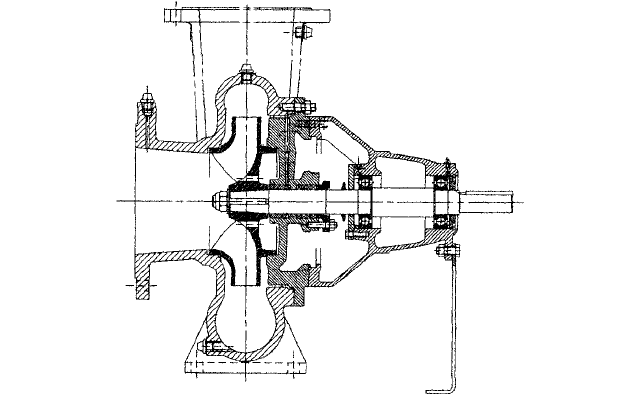
9.66 CHAPTER NINE
FIGURE 11 Large end suction fire pump, typical of units used in Europe (Flowserve Corporation)
• A bronze bearing bushing located behind the impeller that acts as a product lubricated
auxiliary line bearing
• A conical (tapered shaft) impeller fit to ensure no looseness between the mounted
impeller and the shaft (critical when pumps are driven by a diesel engine)
Recommended materials for end suction fire fighting pumps are
Casing: Cast iron or ductile iron
Impeller: Bronze
Shaft: 13% chromium steel
Bearings: Grease-lubricated rolling element bearings
For larger capacities, in excess of 500
—
750 gpm (115
—
200 m
3
/h) in the United States
and above approximately 4000 gpm (900 m
3
/h) in Europe, single stage double suction axi-
ally split case pumps (Figure 12) are required.These larger units are more costly than the
simple single stage overhung designs, but they do offer some advantages that could make
them desirable even at lower flow rates, such as
• The required NPSH is lower (double suction impeller), thus allowing higher operating
speeds.
• The axially split case design provides easy access to the pump interior (neither the
pump nor the driver need to be disconnected) for inspection and rotor removal.
• Axially balanced hydraulic axial forces, and bearings on each end of the rotor supports
unbalanced radial loads.
Recommended materials for single stage double suction axially split case for fighting
pumps are
Casing: Cast Iron
Impeller: Bronze
Shaft: Carbon steel
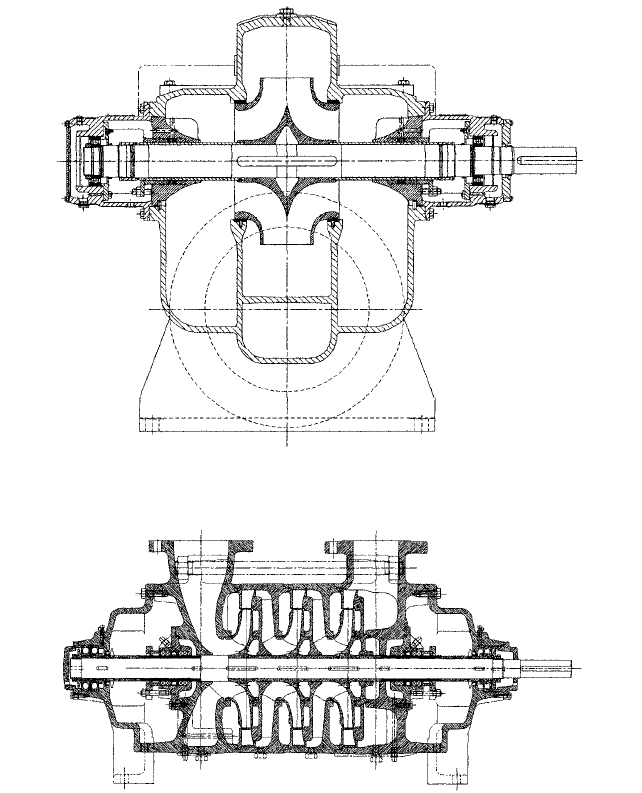
9.4 FIRE PUMPS 9.67
FIGURE 13 Multistage ring-section fire pump (Flowserve Corporation)
FIGURE 12 Single stage double suction axially split case pump used for larger capacities (Flowserve
Corporation)
Sleeves: Bronze
Casing Rings: Bronze
Bearings: Grease-lubricated rolling element bearings
Normally, head requirements for fire pumps do not exceed 260 ft (80 m). For those sys-
tems that do require more head, end-suction and axially split case pumps may be available
up to 450 ft (140 m). Beyond this head range, multistage pumps are typically employed.
Multistage pumps for fire services in Europe are usually of the ring-section design (Figure
13), whereas the axially split case design (Figure 14 shows a typical two-stage pump; Fig-
ure 15 shows a typical multistage pump) tends to be more popular in North America.
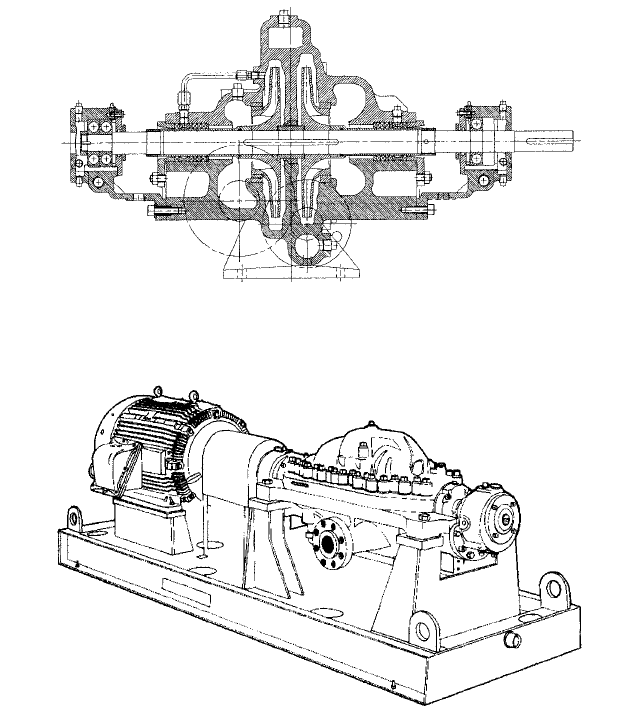
9.68 CHAPTER NINE
FIGURE 14 Two-stage axially split fire pump (Flowserve Corporation)
FIGURE 15 Typically axially split multistage pump used for fire fighting (Flowserve Corporation)
In North America, vertical pumps must be used when the water source is located below
ground. In Europe, where the use of a limited static suction lift is generally permitted,
such vertical pumps are required only when the NPSH available at the suction nozzle of
a horizontal pump would exceed a certain limit, as may be established by national regu-
lations in each country
—
for instance 16.4 ft (5 m) in France.
The submergence of vertical pumps require a particular care. As a minimum, the sec-
ond stage (second impeller up from the bottom end of the pump) should always be sub-
merged below the minimum water level.
The inner column (drive shafting) for vertical pumps is available in either of two
configurations:
• Open line shaft (OLS) construction (Figure 16), within which a steel shafting rotates in
water-lubricated rubber bearings, centered and stabilized by rigid bearing retainers, is
used for static water levels 50 ft (15 m) or less below the pump discharge flange.
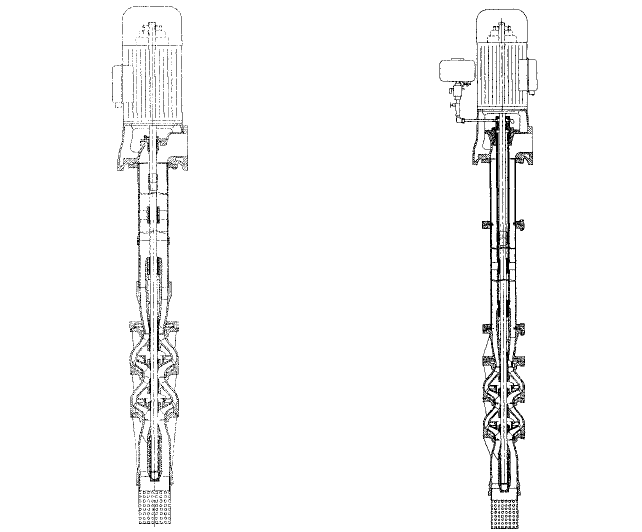
9.4 FIRE PUMPS 9.69
FIGURE 16 Vertical pump with open line shaft
construction (Flowserve Corporation)
FIGURE 17 Vertical pump with enclosed line shaft
construction (Flowserve Corporation)
• Enclosed line shaft (ELS) construction (Figure 17), in which steel shafts rotate in oil-
lubricated bronze sleeve bearings, is used for static water levels of more than 50 ft
(15 m). In ELS construction, the outside of the sleeve bearings are threaded and tubes
enclosing and supporting the bearings and shafts isolate the shafting from the water
being pumped.
If an oil-lubricated line shaft design is utilized, the appropriate environmental protec-
tion or health department should be consulted with regard to special requirements for
installation and protection.
Recommended materials for vertical pumps are
Discharge head and columns: Cast iron or welded steel
Water-lubricated line shaft: Carbon steel protected by non-rusting shaft sleeves
through packing and water-lubricated bearings
(Note: chromium steel shafts typically do not
require shaft sleeve protection.)
Oil-lubricated line shaft: Carbon steel possible, but chromium steel is preferred
Pump shaft: Chromium steel
Bowls: Cast iron
Impellers: Bronze
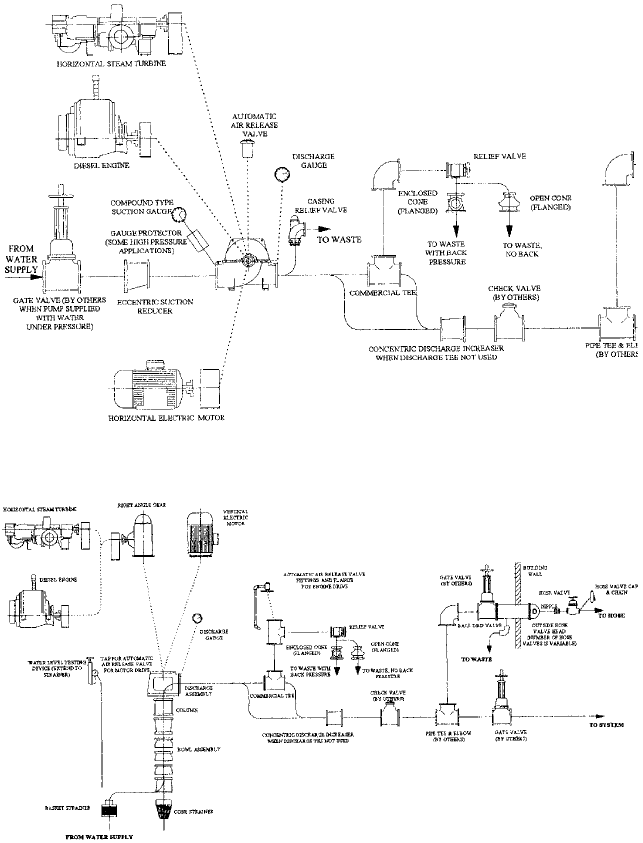
9.70 CHAPTER NINE
FIGURE 18 Typical horizontal fire pump system
FIGURE 19 Typical vertical fire pump system
OVERVIEW OF COMMONLY USED ACCESSORIES_________________________
See Figures 18 and 19 for typical fire pump systems.
1. Common to horizontal and vertical pumps:
a. Casing relief valve To prevent a no-flow condition when system is running at
shutoff
9.4 FIRE PUMPS 9.71
b. Automatic air release valve To vent entrapped air in automatic systems
c. Umbrella cock To vent air in manually operated systems
d. Hose valve head with hose valves, caps, and chains To permit pump flow
(capacity) tests (most modern systems use flowmeters in lieu of hose valve heads)
e. Ball drip valve Installed upstream to prevent freeze damage to hose valve
head installed outside
f. Overflow cone To show whether the relief valve is open
g. Commercial discharge tee with (if required) 90° elbow Used when main
relief valve is required
2. Horizontal pumps only
a. Eccentric suction reducer Required when the size of the suction pipe does
not match the size of the pump suction connection
b. Concentric discharge increaser Required when the size of the discharge
pipe does not match the size of the pump discharge connection
c. Main relief valve Required when pump shutoff pressure plus suction pressure
exceeds system design pressure and when engine or other variable-speed driver
is used
d. Splash partition Used for motor-driven units where hose head are mounted
indoors near pump
3. Vertical pumps only
a. Main relief valve Required when engine or other variable-speed driver is used
b. Water level testing device To determine distance to surface of water; required
for well pump installations
REFERENCES AND FURTHER READING_________________________________
United States
1. American National Standard for Centrifugal Pumps for Design and Application,
ANSI/HI 1.3-2000, Section 1.3.4.1.15, Hydraulic Institute, Parsippany, NJ www.
pumps.org.
2. Factory Mutual Research Corporation, “Approved Guide/Fire Protection
—
A Guide to
Equipment Materials and Services.” 1151 Boston-Providence Turnpike, Norwood, MA
02062.
3. National Fire Protection Association. National Electrical Code, NFPA 70. 1 Battery-
march Park, PO Box 9101, Quincy, MA 02269-9101.
4. National Fire Protection Association. Standard for the Installation of Centrifugal Fire
Pumps, NFPA 20, 1996 ed., 1 Batterymarch Park, PO Box 9101, Quincy, MA 02269-9101.
France
5. “Extinction Automatique A Eau, Type Sprinkler, Regle d’Installation.” APSAD, 26
Boulevard Haussmann, 75311 Paris Cedex 09.
Germany
6. “Rules for Water Extinguishing Systems.” VdS
—
Schadenverhutung, Amsterdamer
Strasse 174, 50735 Koln.
Italy
7. “Norma italiana UNI 9490, Apparecchiature per estinzione incendi.” Uni-Ente
Nazionale Italiano Di Unificazione, Via Battistotti Sassi, 11b, 20133 Milano.
9.72 CHAPTER NINE
United Kingdom
8. “Approved Fire Security Products and Services 1995.” The Loss Prevention Certifica-
tion Board Limited, Melrose Avenue, Borehamwood, Hertfordshire WD6 2 BJ.
9. Borland, G. S., and Greig, A. “Fire Pumps for the Oil and Gas Industry.” ImechE,
C108/87, 1987.
10. Lingenfelder, G., and Shank, P. “Fire Pump Systems
—
Design and Specification.”
Pumps and Systems Magazine, August 1998.
